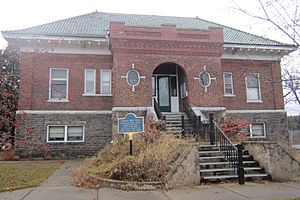History of papermaking in New York facts for kids
The history of papermaking in New York began in the late 1700s. Back then, paper was mostly made from old linen and cotton rags. By 1850, New York had over 106 paper mills, more than any other state! A big step forward happened in 1827. The first Fourdrinier machine in the United States was installed at a mill in Saugerties, New York. This machine changed how paper was made. Later, in 1869, papermaking from wood pulp started in New York. This happened with the Hudson River Pulp & Paper Company in Corinth. It also grew thanks to Illustrious Remington and his sons in Watertown. Their new ideas helped the industry grow a lot in the state.
Contents
Early Paper Mills in New York
Records show that a New York merchant named John Keating opened a paper mill in Manhattan in 1768. We don't have any special marks from that mill, though. In 1772, Keating moved his mill to Continental Village in Putnam County. It ran for a few years until British troops burned it down in 1777 during the American Revolution.
In 1773, a printer and bookseller from Manhattan, Hugh Gaine, started a paper mill. He partnered with Hendrick Onderdonk and Henry Remsen. Their mill was at Hempstead Harbor, which is now called Roslyn, on Long Island. You can find their special watermarks, made from their initials, on New York state laws printed in 1775.
New Ways to Make Paper
The first big invention that changed papermaking was the fourdrinier machine. It was invented in France in 1799 by Nicholas Louis Robert. Later, Henry Fourdrinier and his brother, Sealey, made it even better.
Another important invention was the Keller-Voelter grinder. This machine could turn wood into wood pulp. This was a huge step because it meant paper didn't have to be made only from rags anymore.
In 1866, Albrecht Pagenstecher, an immigrant from Germany, bought two German-made Keller-Voelter grinders. He lived in Stockbridge, Massachusetts. On March 5, 1867, in nearby Curtisville, he became the first person in the United States to make 'groundwood' pulp that could be sold. This was a big deal for the paper industry.
Finding Wood for Paper
Arthur Recknagel, a professor and expert in the paper industry, used to share an interesting story. His uncle, Albrecht Pagenstecher, came back from Germany. He asked his friend, Senator Warren Miller, for advice. Miller suggested they go to Saratoga Springs to look for spruce trees.
From Saratoga, they drove to Luzerne. This place is where the Hudson and Sacandaga Rivers meet. There, they learned that spruce trees were easy to find in these areas. This discovery was very important for making paper from wood.
Hudson River Pulp & Paper Mill
Because of this trip, the Hudson River Pulp & Paper Company was started. In 1869, it began making groundwood and newsprint paper. The mill was located in Palmer, which is in Corinth, New York, near Luzerne.
In 1898, the International Paper Company bought the Hudson River facility. It became their main mill and where their main office was located. Albrecht Pagenstecher even served on International Paper's Board of Directors.
After World War II, workers at the Hudson River mill became very good at making coated papers for International Paper. However, due to changing economic times, the mill closed in November 2002. Nine years later, in 2011, it was planned to be torn down.
Wood-Based Papermaking in Watertown
While Pagenstecher was starting his mill, Illustrious Remington and his three sons were also busy. In 1869, they were making a ton of newsprint every day in Watertown, New York. They used four rag machines and an 84-inch fourdrinier machine.
By 1870, the Remingtons saw that wood pulp was the future. They built three mills on Sewall's Island in Watertown. These mills used the Voelter process. This allowed them to make low-cost, high-quality newsprint. Their paper was 75% rags and 25% wood pulp. This was much cheaper than paper made only from rags, which cost five times more.
Another invention really interested the Remingtons. In 1867, an American chemist named Benjamin Chew Tilghman found that sulphurous acid could dissolve the lignin in wood. This left behind cellulose fibers, which are used to make paper.
Alfred D. Remington learned that a Swede, Carl Daniel Ekman, was teaching papermakers to make paper entirely from wood pulp. He used a sulphite process. Remington went to Sweden to see this "miracle" for himself. He was so impressed that he imported Swedish chemical fiber for several years. Later, he developed his own "sulphite process" at his plant on Sewall's Island.
The Remingtons sold newsprint to the New York Times. Once, they got an order for ten tons of newsprint, but the Times said it must not have any wood pulp! A. D. Remington was proud of his new wood pulp paper. He sent it to the Times with a note, asking them to try it. The Times replied, "come and get your paper," which he did. But it wasn't long before the Times was eager to buy this new, cheaper newsprint.
The way paper was made in the Black River region completely changed. Fourdrinier machines became bigger and faster. The demand for spruce trees was huge, and lumberjacks cut down almost all the old forests. The smell of sulphite mills replaced the smell of tanneries. Other papermakers saw the Remingtons' success. They also started making wood pulp newsprint in large amounts.


